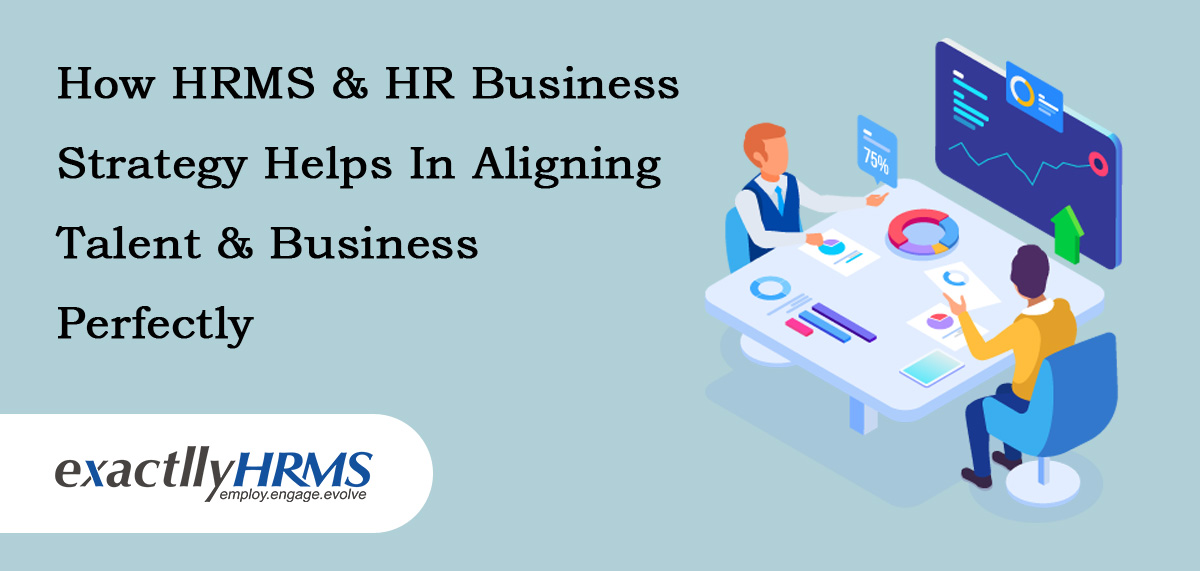How HRMS & HR Business Strategy Helps In Aligning Talent & Business Perfectly

Several factors determine a business’s long-standing objectives & achieving those calls for ascertaining necessary goals.
So how do we simplify the procedure of in-depth scrutiny of the present & estimated situations that might impact the business’s ability to accomplish its mission?
Two words that can make or break any business game – Strategic Planning
Business tactics are future-oriented schemes for enhancing competitive benefits to establish the business’s objectives. Successful implementation of such tactics means each business function must align with its departmental ploy with the entire business strategy.
Sometimes departmental & functional leaders slip into a slight “silo” viewpoint of their strategy. Every function carries different responsibility areas – accounting, marketing, HR, production, etc. The efficient execution of any plan is only possible when each departmental HR business strategy aligns with the entire business strategy.
The HR function is the most involved & impacts the operation & implementation of every other business function. Not only it carries the responsibility of enterprise-wide recruiting but also expands to the whole employment life-cycle. HR function influences other organization functions in areas like employee retention, talent acquisition, safety, compensation, etc.
This calls for immaculate aligning of the HRMS business strategy with the enterprise’s business tactic. This will make achieving business goals just a piece of cake.
Alignment is the association of strategy & execution via communication. Aligning the strategies needs HR to not just comprehend business strategies but also assess the current conditions.
Let’s dive in to know more.
Alignment of HR Strategic Management with business Imperatives:
Do you want your organization’s earning margin to surpass the median 2x? This is definitely possible when the employees not just understand the company but also feel excited regarding the direction the company is actually taking.
The HR is very much a curator of organizational mission and vision and so the onus lies with it for steering the organization to an absolutely new high. By this, we can understand how significant the impact of HR business strategy is on key big business metrics.
HR Strategic Management – Championing High-Performance Enterprises:
The realm of HRMS business management is vast. HR positions the current systems & processes in the correct place. It does so by apprehending the tactful effects of its initiatives. It backs business priorities with accurate HR business strategies. HR effectively implements these duties in these three following ways:
-
Link the Learning Programs with Important Business KPIs –
Strategic HRM calls for investing in L&D or Learning & Development programs. Competency & performance-based training facilitates a learning culture where members of staff receive continuous encouragement for upgrading their expertise & knowledge. They also are motivated to contribute to business goals.
Setting business KPIs holds immense importance for learning programs. As per a study, 76.2% of companies associate learning objectives to the entirety of performance objectives at least to a reasonable extent & 44.5% to a superior or highly elevated extent. More than 80% of companies that actually implemented this could enhance overall revenue. When it comes to the alignment of performance management tactics & L&D programs, it also solidifies the base for efficacious succession planning. This is the space where individual goals also get aligned with the company goals due to the HR business strategy.
-
Inviting the Right Folks on Board –
A dynamic business atmosphere includes regulations, new technologies & competition. These are those pillars that can break or make business plans. However, such challenging situations take a toll when there are skills & talent shortage problems. Overlooking the intricacy of defining the right talent will pose even more issues as it varies with team dynamics & job functions.
Due to this, recruitment procedures must be well-equipped for dealing with several changes by lining up particular skill sets needed across the business initiatives. Another effective HR business strategy is to nurture talent pipelines by functioning with corporate advertising teams & utilizing social media channels. These need to align with the organization’s objectives.
-
Importance of Performance Management –
Keeping a track of the performance of employees is nowadays equivalent to strategic importance. It is not just a tool for checking some boxes at the year-end. There can be no other best way of reinforcing core values other than this. Implementation of HR business strategy is also an effective means of aligning individual performance with the approaches at an organizational level.
HR strategic management & Value Proposition of Talent:
Any HRMS business strategy has the potential of reaching its pinnacle if it accomplishes the value the Talent & HR function brings to the company. On asking this important question in surveys, “Why should HR exist?” it was found that respondents emphasized just people as the greatest asset of an organization. Talent & HR professionals visualize themselves as major-domo’s for the hired hand lifecycle starting from on-boarding to egress. They are actually the ambassadors for the company’s culture.
On top of that, several respondents also considered the attainment of organizational strategy via people strategy. HR business strategy will help in aligning the two & will serve as reliable advisors to both the people & their organization.
The Framework
In the context of structure, Talent & HR departments along with businesses in general are nowadays flatter. The conventional 6 to 7 leadership layers are decreased to 3 or 4 that is also facilitating the de-layering for simplicity & speed. This largely means that people nowadays wear more hats, HR is more responsive to the transforming employee requisites & companies are also less siloed. HR also responds aptly to the changing business structures.
However, it is very important to realize that Human Resource cannot be everything to people every time. It is true that change management is a vital strategic priority for several businesses. But this is also an ability that is sometimes not developed well-enough within the OD/HR function for delivering the expertise to the business.
Manoeuvre & Prioritize HR Strategic Management
To commence with a prioritized HR business strategy, it is vital to consider what is important to the organization. This will be in context to Talent & HR management along with evaluating the lying weaknesses. As per surveys, the companies that are pursuing focused tactics across changing business priorities also have discovered gaps between effectiveness & priorities.
For instance, several companies scored very well in functional HR areas like rewards & payroll. But there was an absence of strength in the strategic areas which are actually higher priorities like leadership, agility, business alignment, etc.
Execution takes place at its best when the emphasis is on the major challenge which is in hand & then dealing with the next challenge.
Few HR business strategy priorities that organizations must focus on are:
- An organization must design a workforce-agile ethnicity so that employees & leaders can estimate the changes for adapting seamlessly in the work environment.
- The HR service model must be agile & incorporated across the organization. Companies can also think of combining high-touch service along with self-service solutions that help in saving money & time.
- The proactive alignment of HR business strategy with business is important. Less emphasis should be on administration & more focus should be on assisting business partners to handle & adapt to transformations easily.
- Talent acquisition endeavours should be focused on critical skills & not a specific experience. Recruiting talent must depend on the capability to learn & adapt & collaborate as an alternative to narrow expertise.
- Delivering real-time data is possible by integrating HRIS & technology platforms. This data is utilized in talent assortment, performance & development. OD or HR organizations can recruit from within for maximizing the prowess of data analytics. This is important in the realm of workforce planning for obtaining accurate information for the company’s strategic planning.
Few Important HRMS Implementation Directives:
These are some of the steps articulated for HRMS development & implementation:
-
Concept Initiation –
An organization must start by identifying the requisites with the setting up of the concept regarding the system. Most importantly, businesses must apprehend the differences that lie between various HRMS tech systems such as HRMS, HRIS & HR Payroll calculators.
-
Discovering the Feasibility Study & Need Analysis –
Building a fitting HRM tech system calls for identifying the need. IT needs a feasibility study for the purpose of quality delivery. HRMS needs to be a vital portion of the transforming procedure investment. This is extremely important for long-standing business growth.
-
Requisite Clarification & Documentation –
Alignment of the purpose & scope with personal & organizational goals is necessary. Apt documentation such as SRS or System Requirement Specification needs to be facilitated for change management.
-
Discovering the Correct Vendor: In House Development & Outsource –
The committee that is nominated can take the decision of either buying AS IS or a custom HRMS solution from a third party vendor. Also, they can incorporate the in-house team from the IT unit for developing a complete system. This is a space where a business must understand that designing & execution depends on feasibility. It also depends on the concerned organization’s plan.
Risk Factors Associated With HRMS Implementation:
It is true that there are several risks associated with HRMS that might pop up when trying to implement it within an organization. But these risks largely differ upon the category of organization & also the business environment. Few common risks that are discovered are mentioned as below:
- Ownership among employees
- Change management for procedure enhancement
- Irrational anticipations from top management
- Need for proper training
- Timely maintenance & quality support for attaining sales right after services
Reasons That Stand Against The Challenges Of HRMS strategic management Implementation:
- Efficacious requirement analysis for Feasibility Study
- The focused and dedicated project team that is devoted to successfully finish the life cycle of the implementation with cost, time & quality parameters
- Security concerns
- Assurance & loyalty from the top management
- Incorporation of techno-functional individuals from seniors & consultants from the organization’s HR-IT unit
- Operation costs
- Effective communication with users
- Technical limitation
Hoist The Bar From Structuring Talent To Structuring A Digital Enterprise:
The present business scenario is full of digital trends that are dislocating companies inside out. This call for avant-garde HR business strategies will help steer business landscapes into the very promising digital future. The disordered business models are on the rise along with hyper-connected & multi-generational members of staff. This is pushing more & more business leaders to function with HR. This will help in shaping the new culture & organizational potentials that are highly important for implementing a digital strategy. On the other hand, HR will also need to continuously redefine itself for becoming decentralized. It can also then seamlessly function with all business aspects for helping construct the latest-gen digital enterprise.
Parting Thoughts:
The foreseeable future finds predictive analytics & workforce planning as the front & center of business. Medium & large sized organizations carry tactics & plans in place with different degrees of success & rigor. The only challenge here is to make every plan embedded & continuous in the HR business strategy.
The talent war though will continue with the age of the workforce & also the nation will experience the least unemployment rates in several decades. Businesses need to be even more proactive in retaining talent. They must also discover ways re-skilling present employees for guaranteeing that their skills can fulfill evolving job demands.
Today’s gig economy makes it extremely challenging to create a robust & consistent culture. This is mainly because the use of virtual talents & contractors is on the rise & these resources turn over recurrently as well. This is an even more big issue for bigger organizations. Just like the way marketers emphasize on customer experience, businesses will also need to provide an arresting employee experience as this will be a method of preserving & attracting talent.
The significance of aligning & prioritizing talent strategies just cannot be exaggerated. Eventually, organizations & their human resource teams need to be professionals in change jointly. This is important for finally offering shape to a more supple workforce & culture & to prosper in such indecisive environments.
Do you need the business strategy growth of your business which is stagnant right now? If yes, then exactllyHRMS is the right solution for you. Wants to know more about exactllyHRMS? Feel free to Contact Us and get a Free Demo.






